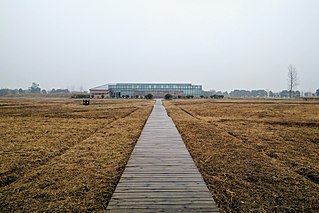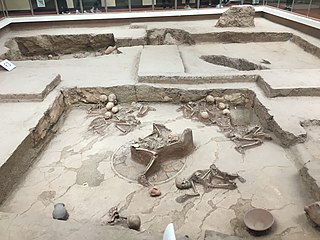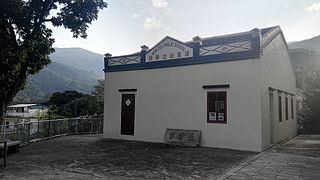 W
WBanpo is an archaeological site discovered in 1953 and located in the Yellow River Valley just east of Xi'an, China. It contains the remains of several well organized Neolithic settlements, like Jiangzhai, carbon dated to 6700–5600 years ago. The area of 5 to 6 hectares is surrounded by a ditch, probably a defensive moat, 5 to 6 meters wide. The houses were circular, built of mud and wood with overhanging thatched roofs. They sat on low foundations. There appear to be communal burial areas.
 W
WBeifudi is an archaeological site and Neolithic village in Yi County, Hebei, China. The site, an area of 3 ha on the northern bank of the Yishui River, contains artifacts of a culture contemporaneous with the Cishan and Xinglongwa cultures of about 8000–7000 BP, two known Neolithic cultures east of the Taihang Mountains, and thus fills an archaeological gap between the two Northern Chinese cultures. The total excavated area is more than 1,200 square meters and the collection of neolithic findings at the site has been conducted in two phases.
 W
WChengtoushan was a Neolithic settlement located on the northwestern edge of Dongting Lake in Li County, Hunan, China.
 W
WChengziya, also spelled Chengziyai, is a Chinese archaeological site and the location of the first discovery of the neolithic Longshan culture in 1928. The discovery of the Longshan culture at Chengziya was a significant step towards understanding the origins of Chinese civilization. Chengziya remains the largest prehistorical settlement found to date. The site is located in Shandong province, about 25 kilometres (16 mi) to the east of the provincial capital Jinan. It is protected and made accessible by the Chengziya Ruins Museum.
 W
WHwando is a mountain fortress of the ancient Korean kingdom of Goguryeo, built to protect Goguryeo's second capital, Gungnae. It is located in present-day Ji'an city of the province of Jilin, China.
 W
WJiahu was the site of a Neolithic settlement based in the central plain of ancient China, near the Yellow River. It is located between the floodplains of the Ni River to the north, and the Sha River to the south, 22 km (14 mi) north of the modern city of Wuyang, Henan Province. Most archaeologists consider the site to be one of the earliest examples of the Peiligang culture. Settled around 7000 BC, the site was later flooded and abandoned around 5700 BC. The settlement was surrounded by a moat and covered a relatively large area of 55,000 square meters. At one time, it was "a complex, highly organized Chinese Neolithic society," home to at least 250 people and perhaps as many as 800.
 W
WJiangzhai is a Banpo phase Yangshao culture archaeological site in the east of Xi'an, where the earliest copper artifacts in China were found.
 W
WJinsha is an archaeological site in Chengdu, capital of China's Sichuan Province. The site is located in Qingyang District, along the Modi River (摸底河). It is named for a nearby street, itself named after the Jinsha River.
 W
WKhara-Khoto was a Tangut city in the Ejin Banner of Alxa League in western Inner Mongolia near Juyan Lake Basin. It has been identified as the city of Etzina, which appears in The Travels of Marco Polo. The present banner Ejin Banner is named after this city.
 W
WKowloon Walled City was an ungoverned, densely populated de jure Chinese enclave within the boundaries of Kowloon City, Hong Kong. Originally a Chinese military fort, the walled city became an enclave after the New Territories were leased to the UK by China in 1898. Its population increased dramatically following the Japanese occupation of Hong Kong during World War II. By 1990, the walled city contained 50,000 residents within its 2.6-hectare (6.4-acre) borders. From the 1950s to the 1970s, it was controlled by local triads and had high rates of prostitution, gambling, and drug abuse.
 W
WLajia is an archaeological site located in Minhe County, Haidong Prefecture in Northwest China's Qinghai province. Lajia is associated with the Qijia culture and was discovered by archaeologists in 2000. The site covers an area of around 200,000 square meters.
 W
WNanzhuangtou, dated to 12,600–11,300 cal BP or 11,500–11,000 cal BP, roughly 9,500–9,000 BC, or 10,700–9,500 BP, roughly 8,700–7,500 BC, is an Initial Neolithic site near Lake Baiyangdian in Xushui County, Hebei, China. The site was discovered under a peat bog. Over 47 pieces of pottery were discovered at the site. Nanzhuangtou is also the earliest Neolithic site yet discovered in northern China. There is evidence that the people at Nanzhuangtou had domestic dogs 10,000 years ago. Stone grinding slabs and rollers and bone artifacts were also discovered at the site. It is one of the earliest sites showing evidence of millet cultivation dating to 10,500 BP. Pottery can also be dated to 10,200 BP.
 W
WPanlongcheng or Panlong City is an archaeological site associated with the Erligang culture during the Shang dynasty period. The site is located just north of the Yangtze river, on the bank of the Panlong lake, and is surrounded by the Fushui river in Huangpi, Wuhan, Hubei, China. Panlongcheng is the largest excavated Erligang site, showing the southernmost reach of the Erligang culture at its peak. It was discovered in 1954, and excavated in 1974 and 1976.
 W
WSanxingdui is the name of an archaeological site and a major Bronze Age culture in modern Guanghan, Sichuan, China. Largely discovered in 1986, following a preliminary finding in 1929, archaeologists excavated remarkable artifacts that radiocarbon dating placed in the 12th–11th centuries BCE. The type site for the Sanxingdui culture that produced these artifacts, archeologists have identified the locale with the ancient kingdom of Shu. The artifacts are displayed in the Sanxingdui Museum located near the city of Guanghan.
 W
WShangdu, also known as Xanadu, was the summer capital of the Yuan dynasty of China that ruled the Mongol Empire, before Kublai decided to move his throne to the former Jin dynasty capital of Zhōngdū, which was renamed Khanbaliq, present-day Beijing. Shangdu then became his summer capital. It is located in the present-day Zhenglan Banner, Inner Mongolia.
 W
WShangxinhe is a former town in the Jianye District of Nanjing, China located on the Jia River (夹江), a tributary of the Yangtze River. The former Wang Hanzhou residence, Jianghan Hall (江汉会馆), Ancient Sun Palace (古太阳宫), and other ancient cultural sites are located in the area.
 W
WQiandao Lake, a human-made, freshwater lake located in Chun'an County, Zhejiang Province, China, was formed after the completion of the Xin'an River hydroelectric station in 1959.
 W
WShimao is a Neolithic site in Shenmu County, Shaanxi, China. The site is located in the northern part of the Loess Plateau, on the southern edge of the Ordos Desert. It is dated to around 2000 BC, near the end of the Longshan period, and is the largest known walled site of that period in China, at 400 ha. The fortifications of Shimao were originally believed by to be a section of the Great Wall of China, but the discovery of jade pieces prompted an archaeological investigation
 W
WTaosi is an archaeological site in Xiangfen County, Shanxi, China. Taosi is considered to be part of the late phase of the Longshan culture in southern Shanxi, also known as the Taosi phase.
 W
WWudi was a town in Wudi County, in the northern Shandong province, which is part of the People's Republic of China. In June 2010, with the approval of the provincial and Binzhou municipal governments, it was dissolved, and together with part of neighbouring Xinyang Township, formed Difeng (棣丰街道) and Haifeng Subdistricts (海丰街道).
 W
WWun Yiu Village is a village located in Tai Po in Hong Kong. Wun Yiu Village consists of Sheung Wun Yiu (上碗窰) and Ha Wun Yiu (下碗窰).
 W
WWunü Shan, which means "mountain of Five Women", is a mountain of historical and cultural significance located in the north of the town of Huanren, in Huanren Manchu Autonomous County, Liaoning Province, China. The tallest peak is the 821 metre-high Main Peak. Jolbon, the birthplace of the ancient Korean kingdom of Goguryeo and its capital from 37 BC to 3 AD, was in Wunü Mountain.